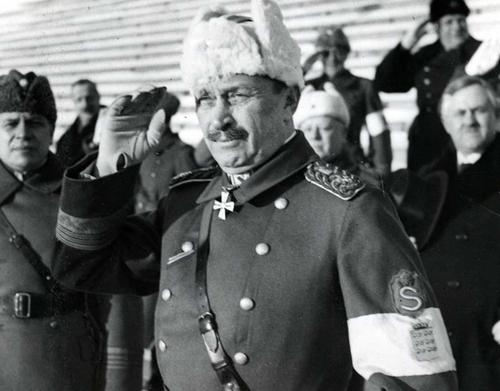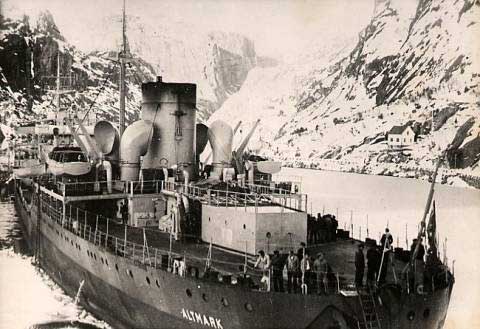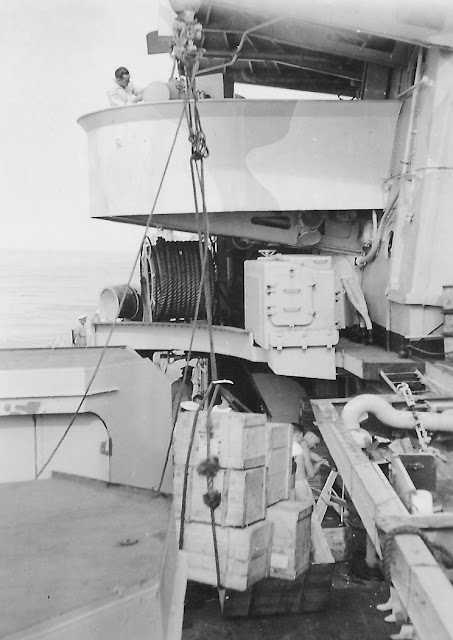Saturday 17 February 1940
 |
| Philip Vian's HMS Cossack returns with its cargo of British sailors released from the Altmark. |
Winter War: The Soviets advance on 17 February 1940 through the Mannerheim Line and draw up upon the V-Line. The Finns are behind this second line of defense. The Finnish 23rd Division has been brought up from reserve to fill a hole in the line, but its arrival is slowed by air attacks. The Red Army has 35 divisions, many fresh or reinforced, under the overall command of General Semyon Timoshenko.
The Finns have 15 divisions, almost all battered from their beating on the Mannerheim Line. There is no chance for the Finns to make a stand ahead of their prepared position because they are no match for Soviet armor on open ground. The Finns start digging in, but the Soviets are right behind them.
The Soviets are not invincible. They try to take Suursaari Island on Lake Muolaanjarvi but are beaten back.
Marshal Mannerheim tells his officers:
Western Front: General von Manstein meets with Hitler at a required dinner for new Corps commanders, and Hitler aid Colonel Schmundt makes sure to have Manstein near him. They talk about Manstein's Fall Gelb plan for an armored thrust through the Ardennes to circumvent the Maginot Line and the BEF.
The plan, unlike the rote, head-on plan drafted by the OKH (Army Command), would create the possibility of separating the BEF manning the line in the north from the French army to the south. Hitler has had similar ideas and now must find a way for the OKW (Command of all German armed forces) and OKH to come to a similar conclusion and draw up the appropriate plans.
Battle of the Atlantic: U-10 (Oberleutnant zur See Joachim Preuss) torpedoes and sinks 1,819-ton Norwegian freighter Kvernaas about four miles northwest of Schouwen Bank, Holland at 02:10. All 20 crew either survive or perish, reports are conflicting.
U-37 (Korvettenkapitän Werner Hartmann) torpedoes and sinks 7,418-ton British freighter Pyrrhus northwest of Cape Finisterre, Spain at 16:00. The Pyrrhus has been traveling with Convoy OG-18, and there are 77 survivors while 8 perish.
U-48 (Kapitänleutnant Herbert Schultze) torpedoes and sinks 3,396-ton Finnish freighter Wilja south of Bishop Rock in southwest England at 20:36. All 35 crew survive, but they are picked up by a southbound steamer and wind up in Havana, Cuba.
British freighter Baron Ailsa hits a mine and sinks.
German freighter Baldur is scuttled by its crew to avoid capture by Royal Navy patrols.
The British at Gibraltar detain the US freighter Exhibitor.
Convoy OB 93 departs from Liverpool, and Convoy HG 19 departs from Gibraltar.
Special Ops: The men rescued from the Altmark are landed from Captain Vian's HMS Cossack at Leith to great acclaim as the government issues a public announcement. Meanwhile, the Germans in Norway stage an elaborate funeral procession for their dead from the incident.
The British, Germans, and Norwegians all protest vigorously to each other about the Altmark Incident, but it is a fait accompli and the diplomatic protests are meaningless. As Hermann Goering liked to say, "Let the cannon speak!"
US Government: President Roosevelt appoints Myron C. Taylor as his "personal representative" to the Vatican.
US Homefront: The United States Lines sells the passenger liner President Harding and seven cargo ships to a Belgian company. This has become a standard practice by US shipowners who still need to do business with Europe. This is covert defiance of President Roosevelt's trade restrictions imposed under the Neutrality Act as amended.
British Homefront: The government draws up a new plan to evacuate the 400,000 children who have returned to London and other large cities.
February 4, 1940: Peace Talks in Stockholm
February 5, 1940: Allies to Invade Norway
February 6, 1940: Careless Talk Costs Lives
February 7, 1940: IRA Terrorists Executed
February 8, 1940: Spies!
February 9, 1940: The Welles Mission
February 10, 1940: Confiscation of Jewish Goods
February 11, 1940: Soviets Attack Mannerheim Line
February 12, 1940: Breaches In Mannerheim Line
February 13, 1940: Soviets Inching Forward in Finland
February 14, 1940: Soviets Batter Mannerheim Line
February 15, 1940: Finns Retreat
February 16, 1940: Altmark Incident
February 17, 1940: Manstein and Hitler Discuss Fall Gelb
February 18, 1940: Operation Nordmark
February 19, 1940: King Gustav Says No
February 20, 1940: Falkenhorst Commands Weserubung
February 21, 1940: Radar Advances
February 22, 1940: Friendly Fire
February 23, 1940: Soviets Present Their Demands
February 24, 1940: Fall Gelb Revised
February 25, 1940: Mr. Welles Comes to Visit
February 26, 1940: Battle of Honkaniemi
February 27, 1940: Finns Retreat Again
February 28, 1940: Overseas Volunteers Help Finland
February 29, 1940: Finns Accept Soviet Terms In Principle
2019
The Finns have 15 divisions, almost all battered from their beating on the Mannerheim Line. There is no chance for the Finns to make a stand ahead of their prepared position because they are no match for Soviet armor on open ground. The Finns start digging in, but the Soviets are right behind them.
The Soviets are not invincible. They try to take Suursaari Island on Lake Muolaanjarvi but are beaten back.
Marshal Mannerheim tells his officers:
“The whole future of our people hangs in the balance. Only our loyalty and endurance can save the day. I am sure every officer will do his duty.”Some 158 American volunteers step off a ship at Oulu.
Western Front: General von Manstein meets with Hitler at a required dinner for new Corps commanders, and Hitler aid Colonel Schmundt makes sure to have Manstein near him. They talk about Manstein's Fall Gelb plan for an armored thrust through the Ardennes to circumvent the Maginot Line and the BEF.
The plan, unlike the rote, head-on plan drafted by the OKH (Army Command), would create the possibility of separating the BEF manning the line in the north from the French army to the south. Hitler has had similar ideas and now must find a way for the OKW (Command of all German armed forces) and OKH to come to a similar conclusion and draw up the appropriate plans.
Battle of the Atlantic: U-10 (Oberleutnant zur See Joachim Preuss) torpedoes and sinks 1,819-ton Norwegian freighter Kvernaas about four miles northwest of Schouwen Bank, Holland at 02:10. All 20 crew either survive or perish, reports are conflicting.
U-37 (Korvettenkapitän Werner Hartmann) torpedoes and sinks 7,418-ton British freighter Pyrrhus northwest of Cape Finisterre, Spain at 16:00. The Pyrrhus has been traveling with Convoy OG-18, and there are 77 survivors while 8 perish.
U-48 (Kapitänleutnant Herbert Schultze) torpedoes and sinks 3,396-ton Finnish freighter Wilja south of Bishop Rock in southwest England at 20:36. All 35 crew survive, but they are picked up by a southbound steamer and wind up in Havana, Cuba.
British freighter Baron Ailsa hits a mine and sinks.
German freighter Baldur is scuttled by its crew to avoid capture by Royal Navy patrols.
The British at Gibraltar detain the US freighter Exhibitor.
Convoy OB 93 departs from Liverpool, and Convoy HG 19 departs from Gibraltar.
Special Ops: The men rescued from the Altmark are landed from Captain Vian's HMS Cossack at Leith to great acclaim as the government issues a public announcement. Meanwhile, the Germans in Norway stage an elaborate funeral procession for their dead from the incident.
The British, Germans, and Norwegians all protest vigorously to each other about the Altmark Incident, but it is a fait accompli and the diplomatic protests are meaningless. As Hermann Goering liked to say, "Let the cannon speak!"
US Government: President Roosevelt appoints Myron C. Taylor as his "personal representative" to the Vatican.
US Homefront: The United States Lines sells the passenger liner President Harding and seven cargo ships to a Belgian company. This has become a standard practice by US shipowners who still need to do business with Europe. This is covert defiance of President Roosevelt's trade restrictions imposed under the Neutrality Act as amended.
British Homefront: The government draws up a new plan to evacuate the 400,000 children who have returned to London and other large cities.
 |
| Marshal Mannerheim in 1940. |
February 1940
February 3, 1940: Soviets Capture a BunkerFebruary 4, 1940: Peace Talks in Stockholm
February 5, 1940: Allies to Invade Norway
February 6, 1940: Careless Talk Costs Lives
February 7, 1940: IRA Terrorists Executed
February 8, 1940: Spies!
February 9, 1940: The Welles Mission
February 10, 1940: Confiscation of Jewish Goods
February 11, 1940: Soviets Attack Mannerheim Line
February 12, 1940: Breaches In Mannerheim Line
February 13, 1940: Soviets Inching Forward in Finland
February 14, 1940: Soviets Batter Mannerheim Line
February 15, 1940: Finns Retreat
February 16, 1940: Altmark Incident
February 17, 1940: Manstein and Hitler Discuss Fall Gelb
February 18, 1940: Operation Nordmark
February 19, 1940: King Gustav Says No
February 20, 1940: Falkenhorst Commands Weserubung
February 21, 1940: Radar Advances
February 22, 1940: Friendly Fire
February 23, 1940: Soviets Present Their Demands
February 24, 1940: Fall Gelb Revised
February 25, 1940: Mr. Welles Comes to Visit
February 26, 1940: Battle of Honkaniemi
February 27, 1940: Finns Retreat Again
February 28, 1940: Overseas Volunteers Help Finland
February 29, 1940: Finns Accept Soviet Terms In Principle
2019











